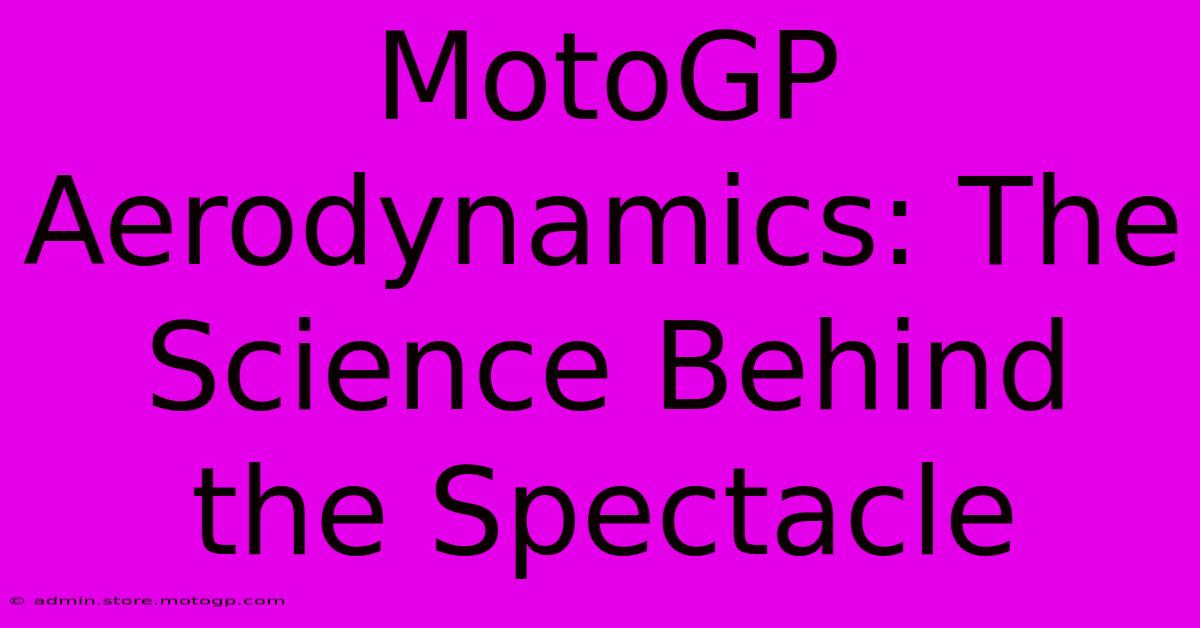MotoGP Aerodynamics: The Science Behind The Spectacle

Table of Contents
MotoGP Aerodynamics: The Science Behind the Spectacle
MotoGP, the pinnacle of motorcycle racing, isn't just about raw horsepower and daring riders. A significant, often unseen, factor contributing to victory is aerodynamics. The complex interplay of air pressure, downforce, and drag shapes the performance of these incredible machines, separating winners from losers by fractions of a second. This article delves into the science behind the spectacle, exploring how aerodynamic advancements fuel MotoGP's breathtaking speed and precision.
Understanding the Aerodynamic Challenges
MotoGP bikes, traveling at speeds exceeding 200 mph (320 km/h), face immense aerodynamic forces. These forces, if not carefully managed, can dramatically impact stability, braking, cornering, and overall speed. The key challenge is to generate sufficient downforce to keep the bike planted on the track while minimizing drag, which resists forward motion.
The Role of Downforce
Downforce is crucial for high-speed cornering. It pushes the bike towards the track surface, increasing grip and allowing riders to lean into turns at incredible angles. This enhanced grip translates directly into faster lap times. Insufficient downforce leads to instability, wheelspin, and potentially dangerous slides.
The Impact of Drag
Drag, on the other hand, is the enemy of speed. It's the resistance the bike experiences as it pushes through the air. Minimizing drag is vital for maximizing top speed on straights. However, reducing drag too much can compromise downforce, creating a delicate balancing act for engineers.
Aerodynamic Components: Shaping the Beast
Modern MotoGP bikes are masterpieces of aerodynamic engineering. Several key components play crucial roles in managing airflow and maximizing performance:
1. Fairings and Bodywork:
The sleek, sculpted fairings and bodywork are not just for aesthetics. Their design meticulously channels air around the bike, minimizing drag and generating downforce. Every curve, angle, and surface is carefully optimized through computational fluid dynamics (CFD) simulations and wind tunnel testing.
2. Winglets:
These small, aerodynamic appendages, often found on the front fairing and sometimes the rear, generate downforce. They work by manipulating airflow, creating a higher pressure zone beneath them and a lower pressure zone above, pushing the bike down. Winglets are a constant area of development and are frequently refined to maximize their effectiveness.
3. Aero-Devices:
Beyond winglets, MotoGP teams continually experiment with more advanced aero-devices. These can include small fins, carefully positioned spoilers, and even adjustable elements that allow riders to fine-tune the aerodynamic balance of their bikes depending on track conditions and corner speed.
The Science Behind the Design: CFD and Wind Tunnels
The development of MotoGP aerodynamics relies heavily on sophisticated technologies:
1. Computational Fluid Dynamics (CFD):
CFD uses complex computer simulations to model airflow around the bike. Engineers can test various designs virtually, predicting their performance before building physical prototypes. This significantly reduces development time and costs.
2. Wind Tunnels:
Wind tunnels provide real-world testing conditions, allowing engineers to fine-tune designs and validate CFD results. Sophisticated sensors and measurement techniques provide valuable data on air pressure, drag, and downforce. The data gathered from these tests is crucial in optimizing the bike's aerodynamics.
The Ever-Evolving Landscape of MotoGP Aerodynamics
MotoGP aerodynamics is a constantly evolving field. Teams are in a perpetual arms race, constantly seeking incremental improvements in downforce and drag reduction. New materials, innovative design techniques, and advanced simulation tools continue to push the boundaries of what's possible, creating ever-faster and more agile machines. The competition is fierce, and the quest for aerodynamic perfection drives the sport's technological advancement, making it an exciting spectacle both on and off the track.
Keywords: MotoGP, Aerodynamics, Downforce, Drag, Winglets, Fairings, CFD, Wind Tunnel, Motorcycle Racing, Technology, Speed, Cornering, MotoGP Bikes, Aero-Devices, High-Speed Cornering, Computational Fluid Dynamics
This article aims for a keyword density appropriate for SEO while maintaining readability and natural language. Remember to use appropriate internal and external linking strategies for off-page SEO.

Thank you for visiting our website wich cover about MotoGP Aerodynamics: The Science Behind The Spectacle. We hope the information provided has been useful to you. Feel free to contact us if you have any questions or need further assistance. See you next time and dont miss to bookmark.
Featured Posts
-
Fastest Ever Predicting Us Grand Prix Sprint Time
Feb 19, 2025
-
Witness The Determination Sprint Race Austin
Feb 19, 2025
-
F1 Parking Get Closer To The Action
Feb 19, 2025
-
The Sting How F1 Drivers Conquer The Competition
Feb 19, 2025
-
Cota Parking Corporate Parking Solutions
Feb 19, 2025
